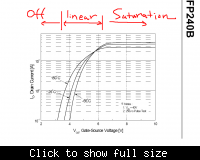eliben
Newbie level 5

Hello,
I'm having a slight confusion over what Rds(on) means for a MOSFET.
In the book it says that Rds(on) is the resistance (Vds / Ids) in the linear (triode) region. After the FET enters saturation, the resistance obviously changes as the current stays the same for increasing voltage.
However, people I ask say that they only use FETs for switching (i.e. either cutoff or saturation), and for them Rds(on) is the resistance in saturation.
Which is right? Can you point to a lucid explanation of this topic?
Thanks in advance
I'm having a slight confusion over what Rds(on) means for a MOSFET.
In the book it says that Rds(on) is the resistance (Vds / Ids) in the linear (triode) region. After the FET enters saturation, the resistance obviously changes as the current stays the same for increasing voltage.
However, people I ask say that they only use FETs for switching (i.e. either cutoff or saturation), and for them Rds(on) is the resistance in saturation.
Which is right? Can you point to a lucid explanation of this topic?
Thanks in advance





